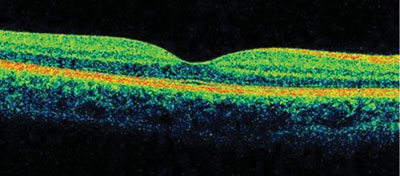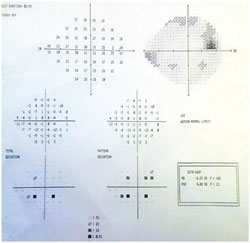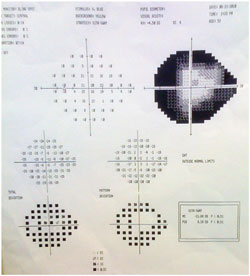Man presents with acute visual loss after trauma
 Priti Batta |
 Namrata Nandakumar |
A 52-year-old man presented to our clinic with a chief complaint of visual loss in his left eye after an altercation with his roommate. The patient reported that he was punched in his face multiple times, kicked in the back of his head and lost consciousness for an unspecified amount of time. When he awoke, EMS was at the scene, and he could not see anything out of his left eye. An hour later he was able to see out of a small area in the center of his vision. He had no flashes, floaters or eye pain.
He was generally in good health and took no medications. His ocular history included hyperopia and presbyopia. He worked as an electrical engineer. He did not smoke and drank a six pack of beer daily.
On examination, the patient’s best corrected visual acuity was 20/25 in the right eye and counting fingers at 6 inches in the left eye. Pupils were equally round and reactive to light with no afferent pupillary defect. Confrontation visual field testing was full in the right eye and could not be preformed in the left eye because the patient could not see the examiner’s nose or finger. Ishihara color plates were 14/14 in the right eye and 1/14 in the left eye (plate No. 2).
On external examination, there was no periorbital edema, ecchymosis or laceration. On slit lamp examination, the conjunctiva was white and quiet in both eyes. The cornea was clear, and the anterior chamber was deep and quiet. There was a mild nuclear sclerotic cataract in both eyes. Dilated fundus exam showed a healthy-appearing optic nerve in both eyes with no evidence of pallor or swelling. The retinal exam was unremarkable in either eye, and there were no tears or detachments noted after scleral depression.
|
|
|
|
Figure 1. Humphrey visual field. Right eye
showed few nonspecific changes. Left eye showed constriction of the visual
field with central sparing.
Images: Nandakumar N, Hedges
TR |
|
 Figure 2. OCT of the left macula showed a good foveal contour and no obvious pathology. |
Humphrey visual fields in the right eye had 9/12 fixation losses and a few nonspecific changes. The left eye had 0/12 fixation losses and constriction with sparing of the central portion of the field (Figure 1). Optical coherence tomography of the macula in the left eye was normal (Figure 2). Retinal nerve fiber layer thickness analysis of the left optic nerve was normal. Fluorescein angiography was unremarkable. A CT scan of the head and orbits was normal without any detectable hemorrhages, masses or compromise of the optic nerve.

What is your diagnosis?
Acute loss of vision, normal exam
The differential diagnosis included retrobulbar optic neuropathy, pituitary tumor with early compressive signs, compromise of the orbital or intracranial portion of the optic nerve, traumatic optic neuropathy, or non-organic visual loss.
In this case, our patient had severe visual loss in the left eye with no afferent pupillary defect. He was unconcerned about his visual loss and was uncooperative during the examination and further testing. He was able to pick out plate 2 on the Ishihara color plates, but was not able to identify the control plate. All of these findings in the setting of a normal examination, CT scan, OCT of the macula and RNFL thickness prompted us to further investigate the possibility of non-organic visual loss.
With the Titmus test, the patient was able to identify the fly, 3/3 animals and 6/9 circles. The Titmus test measures the degree of stereoacuity in arc seconds, and this can be converted into visual acuity. If a patient is able to see 6 of 9 Titmus dots, they should have a visual acuity of about 20/40 in the worse eye. A 10 D base-out prism was placed over the patient’s poorer seeing eye. We observed the normal response in which there was movement of both eyes toward the apex of the prism and a shift back to midline.
Based on our history, findings on examination and ancillary testing, we made a diagnosis of non-organic visual loss and reassured the patient that we were hopeful he would make a full recovery.
Discussion
Non-organic visual loss is defined as the apparent loss of visual acuity or visual field with no substantiating physical signs. It is a challenging diagnosis to make because there is no objective pathology to support the diagnosis, and there is the possibility of missing an organic disease. If suspected, there are several tests available to try to elicit a better than alleged visual acuity. In cases of profound monocular visual loss, as was the case with our patient, an optokinetic nystagmus (OKN) drum can be used. If nystagmus can be induced using an OKN drum at 3 to 5 feet, the patient’s visual acuity must be at least counting fingers. The further the drum is from the patient, the better the visual acuity must be in order to elicit a normal response. The examiner can gradually fog the good eye and ask the patient to read the eye chart, thereby checking the vision in the bad eye without the patient’s knowledge. A Titmus test can reveal a better than alleged visual acuity. Binocular visual fields, in the case of monocular visual loss, would be expected to be essentially normal. Patients with non-organic visual loss will sometimes have a hemianopic field defect because they feel they should not be able to see in the hemifield of the affected eye. A visual evoked potential (VEP) can be done and, if normal, can be helpful in that it provides objective evidence of normal macular function. However, some patients can degrade the VEP by accommodation or by fixating away from the check stimulus.
Once the examiner has enough evidence that there is no organic pathology and the patient’s vision is better than stated, they should not confront the patient. Instead, a follow-up visit should be scheduled, and the patient should be repeatedly told that it is likely that he or she will make a full visual recovery.
In our case, the patient was asked to follow up in 1 week. His best corrected visual acuity was 20/20 in both eyes. Ishihara color plates were 14/14 in both eyes. On Titmus testing, the patient was able to identify the fly, 3/3 animals and 7/9 circles. Humphrey visual field testing showed full fields in both eyes. The patient was happy that his vision had returned to baseline and will be followed for routine exams in our clinic.
References:
- Bruce BB, Newman NJ. Functional visual loss. Neurol Clin. 2010;28(3):789-802.
- Lim SA, Siatkowski RM, Farris BK. Functional visual loss in adults and children: patient characteristics, management, and outcomes. Ophthalmology. 2005;112(10):1821-1828.
- Scott JA, Egan RA. Prevalence of organic neuro-ophthalmologic disease in patients with functional visual loss. Am J Ophthalmol. 2003;135(5):670-675.
- Stewart JF. Automated perimetry and malingerers. Can the Humphrey be outwitted? Ophthalmology. 1995;102(1):27-32.
- Trobe JD. Nonorganic visual disturbances. In: The Neurology of Vision. Oxford, U.K.: Oxford University Press; 2001.
- Namrata Nandakumar, MD, and Thomas R. Hedges III, MD, can be reached at New England Eye Center, Tufts University School of Medicine, 750 Washington St., Box 450, Boston, MA 02111; 617-636-4219; fax: 617-636-4866; website: www.neec.com.
- Edited by Priti Batta, MD, and Namrata Nandakumar, MD. Drs. Batta and Nandakumar can be reached at New England Eye Center, Tufts University School of Medicine, 750 Washington St., Box 450, Boston, MA 02111; 617-636-4219; fax: 617-636-4866; website: www.neec.com.



